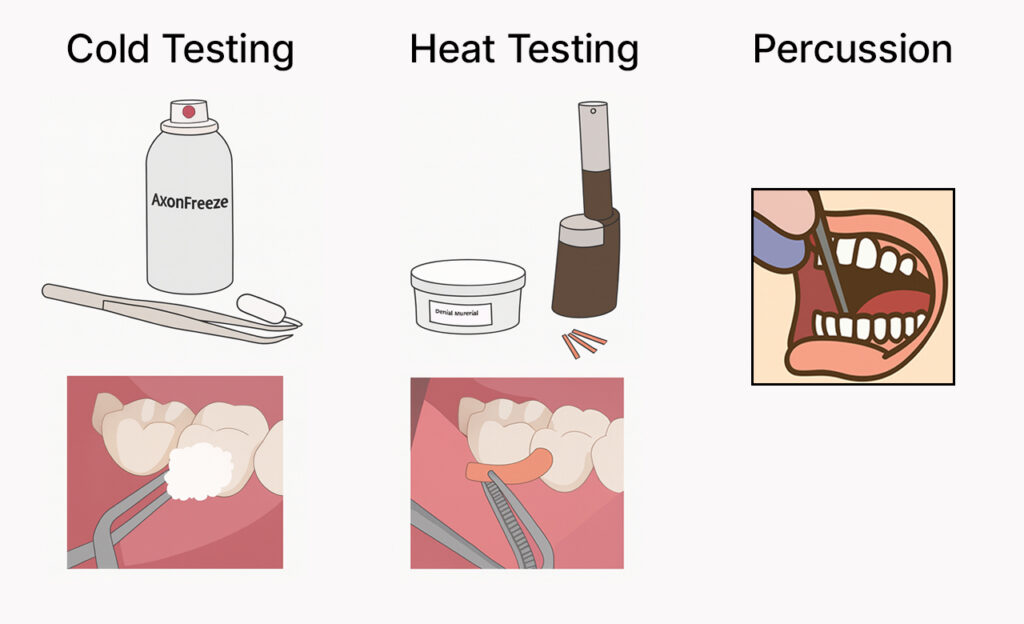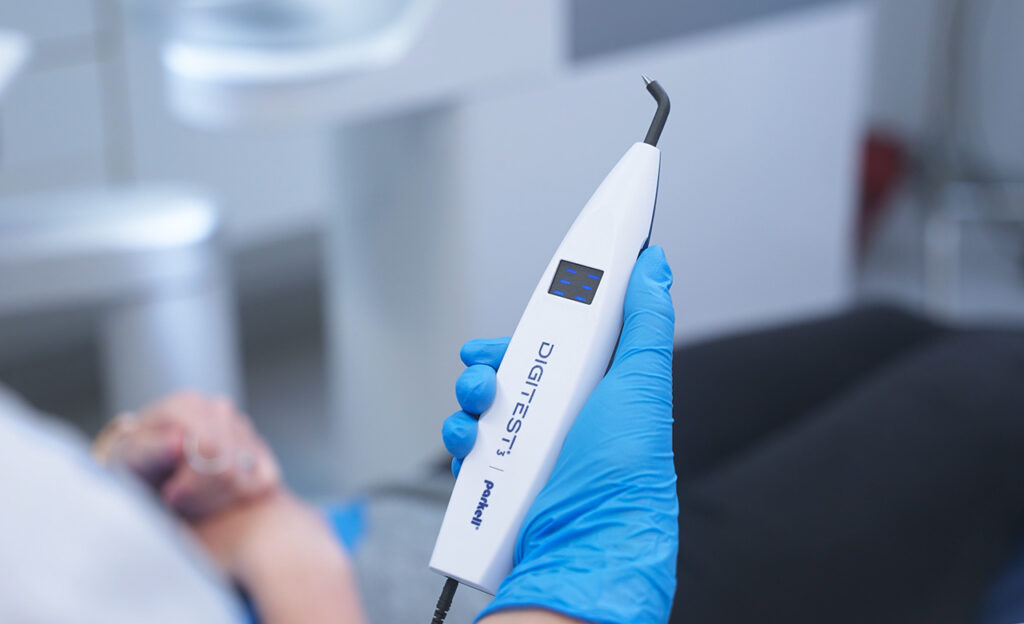Electric Pulp Testers Vs Conventional Pulp Vitality Tests
Pulp vitality testing is a simple but critical step in diagnosing tooth pain and planning treatments like root canals and restorations. This diagnostic process helps dental clinicians determine whether the dental pulp—the nerve and blood vessels inside the tooth—is healthy, inflamed, or necrotic.
Alongside conventional pulp tests such as cold, heat, or percussion methods, dentists are increasingly opting for electric pulp testers for more precise results. This raises an important question: when it comes to pulp vitality tester accuracy, which method works best? Before we compare electric pulp testers with other available diagnostic tools, let’s spend a few words about what pulp vitality testing really means.
What Is Pulp Vitality Testing?
Pulp vitality testing is a diagnostic method used to evaluate the health of the tooth’s pulp tissue. Its main purpose is to detect pulp damage, inflammation, or necrosis. You can read more about pulp testing techniques and effectiveness from this clinical review.
Furthermore, accurate pulp testing helps dentists make informed decisions, such as whether a tooth needs a root canal or can be saved with conservative treatment. As we know, there are several ways to measure pulp vitality. Further, we will dig deeper into them.
Conventional Pulp Testing Methods

There are different types of pulp testing methods which dentists have long relied on, and many that are currently being tested. Each of these pulp testing methods has its own specific purpose in diagnosing pulp health. You can read this article to learn more about current pulp testing methods and trends. Also, all methods present limitations and may not always deliver accurate pulp vitality readings, especially in teeth with crowns or root restorations. Below are some of the most common methods.
Cold Test – Applying ice sticks, refrigerant sprays, or CO₂ snow to the tooth surface to check sensitivity.
Heat Test – Using warm instruments or heated gutta-percha to stimulate the pulp.
Percussion Test – Gently tapping the tooth to assess tenderness or periapical inflammation.
Pros of Conventional Pulp Tests
1. Simple, low-cost, and widely available.
Cons of Conventional Pulp Tests
1. Results are subjective and depend on patients’ response.
2. Influenced by restorations, enamel thickness, and individual pain tolerance.
3. Deliver a “yes or no” response, in other words they can only detect whether the stimulation produces a response or not.
4. Possible false test results in immature, heavily restored or traumatized teeth.
Electric Pulp Testers

Electric pulp testers are easy-to-use diagnostic devices designed to evaluate the vitality of dental pulp by delivering a small, controlled electrical stimulus to the tooth. In contrary to thermal or percussion tests, electric pulp testers provide a more objective assessment of pulp nerve response.
Further, if you want to learn more about electric pulp testers, please read this Parkell’s Digitest 3 electric pulp tester and its essential accessories that help in enhancing diagnostic accuracy.
Pros of Electric Pulp Testers
1. Quantifiable readings for greater objectivity and easier follow-up.
2. Faster and often less stressful for patients.
3. Less affected by tooth anatomy, enamel thickness, or restorations
4. Also, quick and reliable assessment of pulp vitality, even in crowned or restored teeth when used with precision probes.
5. Moreover, greater accuracy than cold testing in elderly patients and teeth with canal obliteration as shown in this recent study on head and neck cancer
6. Improved patient experience and excellent aids for communication with the patient
Cons of Electric Pulp Testers
1. Indicate nerve response only, not actual blood flow in the pulp.
2. Not suitable for healthy immature teeth and orthodontic patients.
3. Although, recent studies show no interference effects, manufacturers contraindicate their use on patients and by operators wearing cardiac pacemakers and other corporeal electric devices such as internal defibrillators and insulin pumps.
4. Imply a slightly higher initial investment compared with mainstream vitality tests.
Key Comparison: Electric Pulp Testers vs Conventional Tests
| Factor | Electric Pulp Testers | Conventional Pulp Testers |
| Accuracy | More precise, consistent readings | More subjective, higher chance of error |
| Patient Comfort | Quick, mild tingling sensation | Can be uncomfortable or prolonged |
| Reliability | Consistent across different tooth types | Influenced by external factors |
So, overall, electric pulp testers generally provide greater diagnostic accuracy and reliability compared to traditional pulp testing methods.
Why Modern Dentists Are Shifting to Electric Testing.
Across clinics in the EU and worldwide, more dentists are adopting electric pulp vitality testers because of the following reasons:
- Objective, measurable and comparable values.
- Enhanced patient experience by faster and less invasive diagnosis
- Better documentation and record-keeping for long-term monitoring.
- Reduced risk of misdiagnosis.
- Better check-up of crowned teeth and follow up of trauma and deep restorations.
Why Pulp Vitality Tester Accuracy Matters and How We Secure It
Studies show that a combination of tests provides more accurate diagnosis than does any test alone. Relying only on thermal pulp tests or percussion increases the risk of false results leading to unnecessary or postponed treatments. Equipping your dental clinic with a reliable electric pulp tester like Digitest 3 means safer readings and peace of mind, knowing your treatment is based on accurate diagnosis.
Conclusion
Electric pulp testers and conventional pulp tests complement each other in dental diagnostics. While thermal tests remain valuable for evaluating tooth sensitivity, electric testers provide objective, precise and repeatable measurements of pulp vitality, enhancing diagnostic accuracy.
Electric pulp testers offer superior accuracy, reliability, and patient comfort—making them the preferred choice for modern endodontic diagnostics. Therefore, electric pulp testers are widely recognized as a reliable method for accuracy and consistency.
Ready to take your pulp vitality testing to the next level? Don’t settle for guesswork or inconsistent results — choose Parkell’s Digitest 3 today from here. If you want to be in touch with us, you can also contact us and visit our website.
